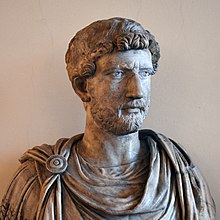The Panhellenion (Greek: Πανελλήνιον) or Panhellenium was a league of Greek city-states established in the year 131–132 AD by the Roman Emperor Hadrian while he was touring the Roman provinces of Greece. The League was established following a ceremony at the Temple of Olympian Zeus in Athens, the capital city of the Panhellenion. Evidence suggests that the Panhellenion continued to survive until the 250s AD.[1]

Hadrian was a philhellene and idealized the Classical past of Greece; this was his own, personal attempt to recreate the apparent "unified Greece" of the 5th century BC, when the Greeks took on the Persian enemy.[citation needed]
The Panhellenion was primarily a religious organization, and most of its deeds were related to self-governance. Admission to the Panhellenion was subject to the scrutiny of a city's Hellenic descent.[citation needed]
In 137 AD, the Panhellenic Games were held at Athens as part of the ideal of Panhellenism and harking back to the Panathenaic Festival of the fifth century.[citation needed]
From inscriptions found, member cities included Athens, Megara, Sparta, Chalcis, Argos, Acraephiae, Epidaurus, Amphicleia, Methana, Corinth, Hypata, Demetrias, Rhodes, Thessalonica, Magnesia on the Maeander, Eumeneia, Cyrene, as well the cities of Crete.[2][3]
The name was revived by the first governor of modern Greece, Ioannis Kapodistrias, for a short-lived advisory body in 1828.[citation needed]
References
edit- ^ Spawforth, Antony (7 March 2016). "Panhellenion, Attic". Oxford Research Encyclopedia of Classics. doi:10.1093/acrefore/9780199381135.013.4699. ISBN 978-0-19-938113-5. Retrieved 20 August 2024.
- ^ Boatwright, Mary T. (2003). Hadrian and the Cities of the Roman Empire. Princeton University Press. p. 147.
- ^ Oliver, James Henry (1970). Marcus Aurelius: Aspects of Civic and Cultural Policy in the East. Hesperia. Vol. Supplement XIII. Princeton, NJ: American School of Classical Studies at Athens. p. 130.
Further reading
edit- Benjamin, Anna S. (1963). "The Altars of Hadrian in Athens and Hadrian's Panhellenic Program". Hesperia: The Journal of the American School of Classical Studies at Athens. 32 (1): 57–86. ISSN 0018-098X. JSTOR 147351.
- Boardman, John; Hammond, N. G. L.; Lewis, D. M.; Walbank, F. W.; Astin, A. E.; Crook, J. A.; Lintott, Andrew; Rawson, Elizabeth; Bowman, Alan K.; Champlin, Edward; Cameron, Averil; Garnsey, Peter (2005). The Cambridge Ancient History. Cambridge University Press. ISBN 0-521-26335-2.
- Nasrallah, Laura (2008). "The Acts of the Apostles, Greek Cities, and Hadrian's Panhellenion". Journal of Biblical Literature. 127 (3): 533–566. doi:10.2307/25610139. ISSN 0021-9231. JSTOR 25610139.
- Riccardi, Lee Ann (2007). "The Bust-Crown, the Panhellenion, and Eleusis: A New Portrait from the Athenian Agora". Hesperia: The Journal of the American School of Classical Studies at Athens. 76 (2): 365–390. doi:10.2972/hesp.76.2.365. ISSN 0018-098X. JSTOR 25068025. S2CID 191590607.
- Romeo, Ilaria (2002). "The Panhellenion and Ethnic Identity in Hadrianic Greece". Classical Philology. 97 (1): 21–40. doi:10.1086/449565. ISSN 0009-837X. JSTOR 1215544. S2CID 161974097.
- Spawforth, A. J. S. (1999). "The Panhellenion Again". Chiron. 29: 339–352. doi:10.34780/c661-9c62.
- Spawforth, A. J.; Walker, Susan (1985). "The World of the Panhellenion. I. Athens and Eleusis". The Journal of Roman Studies. 75: 78–104. doi:10.2307/300654. ISSN 0075-4358. JSTOR 300654. S2CID 154814654.
- Spawforth, A. J.; Walker, Susan (1986). "The World of the Panhellenion: II. Three Dorian Cities". The Journal of Roman Studies. 76: 88–105. doi:10.2307/300367. ISSN 0075-4358. JSTOR 300367. S2CID 162844591.
- Wörrle, Michael (1992). "Neue Inschriftenfunde aus Aizanoi I". Chiron (in German). 22: 337–376. doi:10.34780/1a9w-zn4e. ISSN 2510-5396.